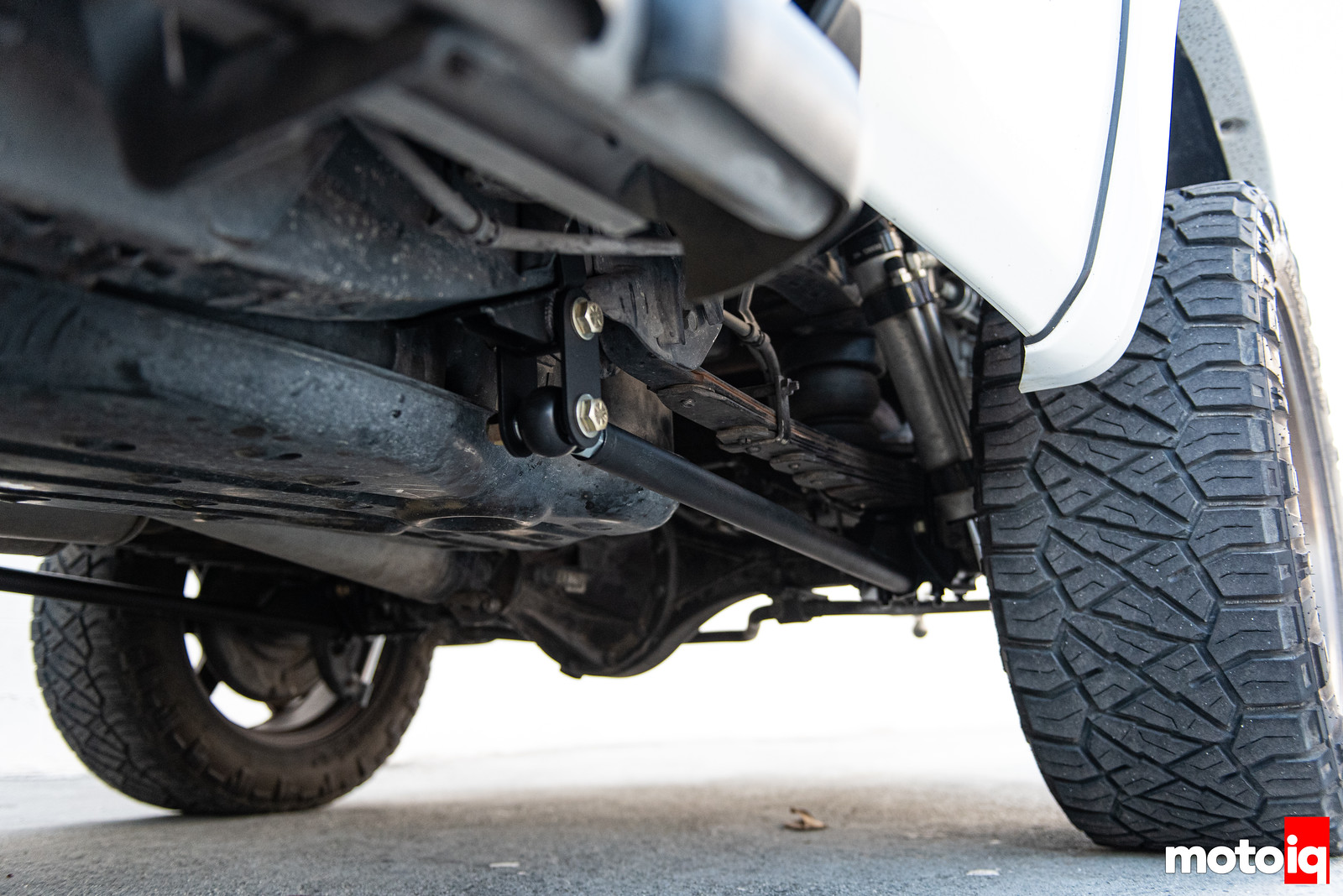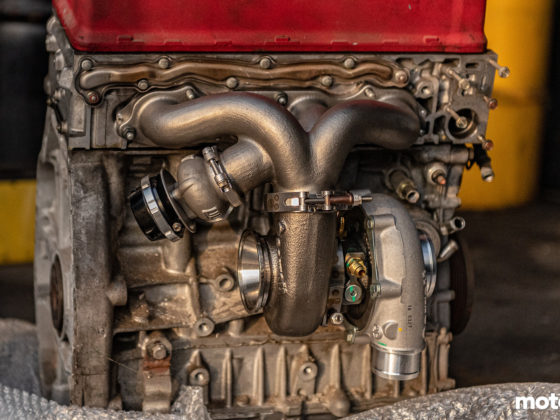
When you combine big power, big tires and a limited slip differential with leaf springs you have a recipe for the enemy of traction and your driveline parts, wheel hop. Wheel hop is when the torque of the engine working against the traction of the tires, twists the rear axle assembly in a clockwise direction, bending the leaf springs. When the tires break traction, the axle can snap back, catch traction, twist, and break traction again, over and over in a cycle that builds up to where the tires are hopping off the ground. This causes a loss of traction which hurts on pavement and off road driving. Wheel hop is very hard on parts and can lead to failure of the differential, ring and pinion, axles, transmission and drive shaft. The problem is bad on supercharged Tundras like ours which are known to break the rear U Joint on the driveshaft even though the rest of the rear end is pretty sturdy. Fortunately SDHQ Motorsports has come up with a solution for this issue.
Toyota has staggered the rear shocks to help reduce wheel hop from the factory and our stiffer heavy duty Icon rear springs coupled with the increased damping from the Icon shocks have eliminated about 70% of our obvious wheel hop. However, when we did a drag launch you could feel a nibbling vibration and the burnout marks would be striped, showing where the tires were hopping while spinning. The wheel hop was worse off road in the dirt and it was awful when turning right on the street from a dead stop and trying to give it gas to get out in traffic quickly, the wheels would hop badly and the traction control would come on hard, causing the truck to bog in traffic instead of accelerate like you needed it to! We hoped the SDHQ bars would help us with these issues.
Check out all the cool stuff we did to our Project Tundra!

The SDHQ bars are made out of thick walled, tig welded 4130 chrome moly and are super strong, strong enough to withstand impacts from rocks and other offroad hazards. They are designed to fit most popular aftermarket springs as well as the stock springs.

The SDHQ traction bars come with high quality hardware and spherical bearings with this cool glove like dust boot for the spherical bearings.

The SDHQ axle brackets are strong and tough. These replace the stock brackets underneath the axle and provide mounts for the traction bars.

The revolutionary feature of the SDHQ traction bars that sets them apart from any other bar is this swinging forward mount. Normally we do not recommend traction bars for anything other than drag racing and especially not for anything that has to handle in turns or go off road. This is because old school traction bars do not allow the rear axle to twist without binding. The binding means that in cornering, the rear roll stiffness is ramped up quickly as the axle binds. This causes sudden oversteer and a loss of traction as the inside rear wheel will get lifted off the ground. In off road, the rear axle cannot articulate causing a huge loss of traction on uneven surfaces. This pivoting link allows the traction bar to work while allowing for full twist and articulation! We will show you how this works in a bit.




10 comments
The heim joint dust boots are great. A lot of New England area 240SX guys ran them on their adjustable arms back 10-15yrs ago. The only issue is that they also hold stuff in- unwanted debris still do find their way in. So it is a good idea to periodically check them- clean them out and keep them filled with fresh grease.
I had the heim boots on my Mustang for about 3 years and 40k miles, lived on a gravel road, never had an issue with them. I never filled it with grease tho so maybe thats the difference, grease does likes to catch debris…
for anyone wondering, I got mine from SealsIt.com
How are the traction bars with a double articulated forward mount doing any thing? Under load the axle would have to roll like 20 degrees before the forward bar mounts wold begin sucking up a fraction of the load due to the angle of the shackles. It looks more like the additional bump stops on the rear mount are doing more of the work to control axle roll than anything else.
The traction bars engage immediately. When the mount is adjusted correctly it is perpendicular to the force applied to it.
If you look at the 3rd picture on page 4 and use some imagination you can see that when the axle starts to twist the bump stop at the end of the bar will bind against the axle bracket turning the bar into a leaver arm that is trying to move vertically up. With the front swing bracket in a vertical position all the force is transferred vertically through the swing mount into the frame stopping axle twist. It could have been explained better, I had to go overt the pictures a few times to understand what is going on. But a very ingenious design!
Hi Mike,
In the 1980’s my friend in Seattle purchased a 1969 or 1970 Shelby King Cobra with 428. Factory roll bars, short 4sp straight cut gear box, radio and heater delete, koni adjustables. If I remembered correctly that car came with traction bars and the forward pickup was inboard. I think it also had a Panhard or Watts Link to prevent the rear axle from shifting side to side. I was told this was to control the leaf spring live axle.
He bought the car for less than $5,000 and sold it for less than $10K. He was not able to get a dual plate clutch that came in the car. He had difficultly getting parts for the huge Holley carb. He couldn’t get the dual points need for his distributor. It was an original Mustang raced by Shelby America in California. it raced less than one season. The fiberglass hood had huge numbers of naca ducts. He could not source the huge brake components. Imagine the price of that car today.
The Shelby bars were made by traction masters and they did not articulate but bolted solidly to the axle and the body. They had a lot of bind and although they stopped axle windup, they had a big negative effect on handling. On the other hand cars in those days did not handle too well.
Hi Mike, Jup, you’re right. Get leaf spring winding, live axle shaking side to side in the corners or suspension bind.
I don’t know if you remember, but in late 1980’s 1990, I was running a 1968 Firebird and 1969 convertible Firebird. The 400+ ci engines made so much torque. 1st fried the clutch, installed 3200 lbs ram clutch, which made your legs shake just to engage it. Then blew out the transmission syncro’s, u-joints and twisted the drive-shafts. I was still running the rubber donut sub-frame connectors, so the car looked all twisted, changed those to aluminum donuts. Beefed everything up then it torqued the leaf spring completely out of the chassis. That’s when I had Morrison and Al Green, build me some hidden traction bars attached to the top side (like the Chevelle SS and Ballard Springs rearc and put more spring in the leaf spring. I think I tried to put a panhard link, but that created evil handling with hidden top-side-triangulated traction bar.
Ha, ha, ha, old day racing. I worked for Good year, changing rubber after school, so got good price or free “Blue Dot” barely legal street racing tires. Lucky to get 1,000 miles out of those tires.
Love your stories, love the story about Dog Car. I remembered that car. I think that’s when we last met. I was working in Costa Mesa Ca. and drove up and down to San Fran. to meet friends and families. i also worked in Pittsburg Ca. and raced rent-a-car at Sears Point in 1980’s.
Hi Mike, That King Cobra have not been seen at any show for decades. It also came with Magnesium wheels, which SIR and PIR banned because of corrosion. He sourced some factory Aluminum King Cobra wheels. The tires were Goodyear Blue Dot (barely legal. The second owner told him Shelby America converted to street legal trim. Yet it had the most twisted headers. It seem like Shelby America took off the number plate and decals, then repainted the car and called it street legal. My friend licenced it in Seattle and drove it for many years until it needed repair and maintenance. It would be an interesting car to hunt down. The original factory and Shelby America build sheets were under the front seat carpeting.
That’s a cool history, that car is worth a fortune now!